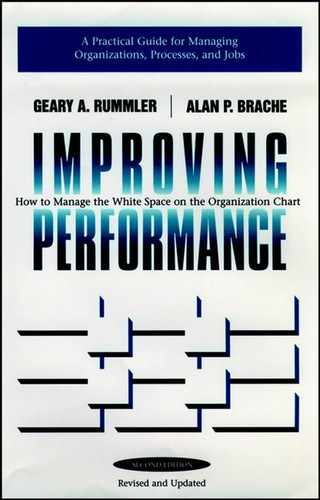Chapter 4. THE ORGANIZATION LEVEL OF PERFORMANCE
All are but parts of one stupendous whole.
—Alexander Pope
A wealthy owner of a baseball franchise will often recruit the most highly skilled (and highly priced) talent and wonder why his or her team doesn't win the World Series. A championship team often pales in position-to-position matchups; it wins because somehow the "stupendous whole" is greater than the sum of its parts. The distinction is usually that the winning team as a whole, not just each individual player and function (hitting, pitching, defense), is being managed.
Similarly, an organization can be greater than the sum of its parts only if the whole organization is managed. An organization may have people with outstanding experiential and academic credentials. Its functions, such as marketing, production, and research, may look good when benchmarked against those departments in other organizations. However, its results may be less than stellar because its executives manage functions and people without placing them in a larger organizational context. This practice is a prescription for suboptimization, a situation in which the whole equals less than the sum of its parts. Our first step in managing organization performance—Level I of the Three Levels—is to acknowledge the viewpoints that often characterize the current situation.
The Customer's View of the Organization. 'What is going on with these people? Why can't they give me a product that does what I need it to do and is available when I need it? Where is the follow-up service I was told I'd be getting? Why do I feel that I know more about the product than they do? Why do I have to deal with a different person each time I contact them? Why can't these people get their act together?"
The Supplier's View of the Organization. 'Why don't these people ever know what parts they need more than three days ahead of time? Do they realize that because we have to expedite nearly every order, they end up paying top dollar? Why do they keep changing the specifications? Why do they discontinue at least one product every six months, which results in a large number of part returns? Why don't they ever take us up on our offer to visit their plant, at our expense, so we can learn what's happening in their business? Why can't these people get their act together?"
The Employees' View of the Organization. 'Why can we match our competitor's quality only by dramatically increasing inspection (which drives our costs through the roof)? Who told sales that we have the capability to offer that service and meet that deadline? Where do the product development people come up with these ideas? So, what are our priorities this week? Why don't section managers cooperate with each other? Don't these people realize that if we don't change the way we do business, we won't survive? How does top management expect us to believe that quality comes first when, at the end of every month, they say 'I don't care; ship it!'? Why are these people, who are paid above the industry average, still not motivated? Why can't we get our act together?"
The Shareholders' View of the Organization. 'Why do I continuously see reorganizations, executive shuffles, product launches, and improvement campaigns, but no money in my pocket or increase in the value of my stock? Why can't these people get their act together?"
